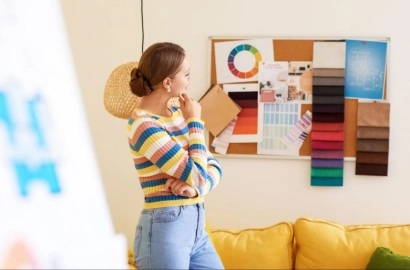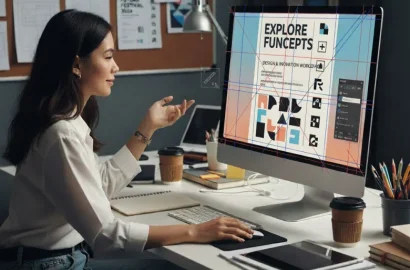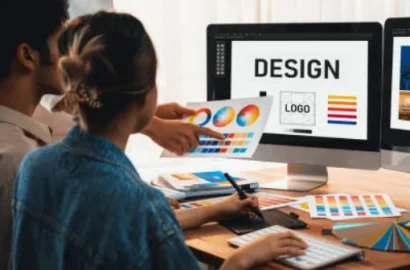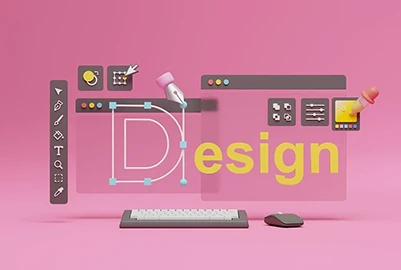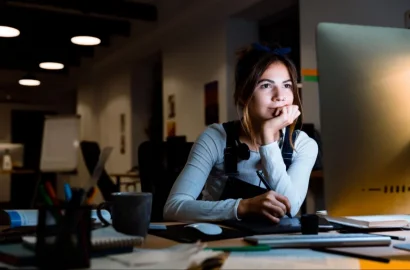Learn everything you need to know about animation design—including key principles, the process, top skills, and salaries.
If you’re looking for a career that combines creativity, technical know-how, and a flair for storytelling, you may well find yourself at home in animation design.
Animation design is the very special art of bringing ideas to life through motion. It’s the magic behind some of the most popular movies, video games, and cartoons—and it offers a highly rewarding career path for those with the necessary skills and passion.
So what exactly is animation design and what does an animation designer do?
We’ve covered everything you need to know in this guide, including:
- What is animation design?
- The 5 main types of animation design
- The 12 fundamental principles of animation design
- An overview of the animation design process
- What is an animation designer?
- What does an animation designer do?
- What are the most important skills for an animation designer?
- How much do animation designers earn?
- How to get started with animation design
- Learn more about the design industry
Let’s begin.

What is animation design?
Animation design is both a creative and technical discipline that brings static elements to life through sound and motion.
Consider a cartoon character jumping and running around, or a virtual firework exploding when you click a certain button on a website. That’s animation design in action.
Animation design is all about visual storytelling—creating engaging animations that captivate, guide, and inform the viewer. It involves creating a series of frames or images that are played in rapid succession to give the illusion of fluid, continuous motion.
There are many different applications of animation design: from movies and educational videos to animations for marketing, advertising, websites, and apps.
We’ll take a closer look at the different types of animation design in the next section. First, though, let’s consider how animation design differs from the broader field of graphic design.

What is the difference between graphic design and animation design?
Both graphic design and animation design focus on communicating a specific message to the target audience, and they use many of the same fundamental principles.
However, the key difference between animation design and graphic design is the use of motion. Graphic design typically focuses on creating static visual elements and materials—such as logos, typography, posters, book covers, and branding materials (to name just a few).
Animation design, on the other hand, brings static visuals to life through movement. It builds upon fundamental graphic design principles, such as composition and color theory, but adds dynamic elements such as motion, transitions, and interactivity.
The 5 main types of animation design
There are five main types of animation design, each with its own unique use cases, techniques, and mediums.
2D animation
In 2D animation, images are drawn frame by frame in two dimensions (i.e. without depth or 3D perspective). This type of animation design is commonly used for cartoons (like The Simpsons), explainer videos, and educational content.
3D animation
3D animation involves creating life-like 3D models that move and interact in virtual space. This type of animation design is used in contexts where you want to create an immersive experience for the viewer—like movies and video games. If you consider films like Frozen and Toy Story, are classic examples of 3D animation design.
Motion graphics
Motion graphics is a type of animation design typically used in branding, marketing, and advertising. It involves bringing graphical elements to life through motion—such as dynamic logos, animated infographics, or promotional videos. You can learn more in this complete guide to motion graphic design.

Stop-motion animation
Stop-motion animation is an advanced animation technique that involves moving physical objects incrementally and then photographing them frame by frame. When these individual frames are put together in a sequence, it then creates the illusion of motion. If you’re familiar with Wallace & Gromit, you’ve seen stop-motion animation in action.
UX and UI animation
In UX and UI design, animation can be used to create dynamic and engaging interactions for apps, websites, and other digital products. In this context, animations help to guide the user, provide visual feedback, enhance usability, and create a more exciting user experience.
Now that we’re familiar with the different types of animation design, let’s consider the key principles that underpin this fascinating field.
The 12 fundamental principles of animation design
There are 12 fundamental principles that help animation designers to create designs that feel fluid, engaging, and convincing. These principles were originally developed by Disney animators, and now serve as a universal set of guidelines.
1. Squash and stretch
This principle adds weight and flexibility to objects and characters by exaggerating their movement. For example, a bouncing ball might squash when it hits the ground and stretch when it rebounds, making it feel more life-like.
2. Anticipation
Animation designers use the anticipation principle to prepare the audience for an action that’s about to happen. An animated cartoon character might crouch down before they jump, for example, giving the viewer a visual cue as to what action is about to come.
3. Staging
Animation design is all about visual storytelling, so it’s essential to guide your audience’s attention and make sure they’re focused on the most important elements. Staging is like composing a shot in a movie, considering how different actions in the sequence are framed and presented to the viewer.
4. Straight ahead action and pose to pose
This principle comprises two different approaches to drawing frames for an animation. With the ‘straight ahead action’ technique, you animate frame-by-frame from start to finish, creating a more fluid sense of movement.
With the ‘pose to pose’ technique, you create all key frames first, then fill in the motion. This allows for more precise control.

5. Follow-through and overlapping action
Follow-through refers to the way parts of an object or character continue to move after the main action has finished—like hair or clothes continuing to swish after a character has stopped running, for example. Overlapping action is when different parts of an object or character move at different speeds, creating more realistic motion.
6. Slow in and slow out
This principle is based on the premise that objects speed up when they start moving and slow down before they stop (imagine a car traveling at speed and then slowing down to park, for example). Incorporating this principle helps to convey movement in a way that’s realistic and life-like.
7. Arcs
The principle of arcs refers to the idea that, in real-life scenarios, most natural movements follow a curved pathway rather than a straight line.
Consider how a person’s arms might swing as they walk, for example, or the pathway an object might follow as it’s thrown into the air and lands back down on the ground. In animation design, arcs help to create movements that look fluid and realistic.
8. Secondary action
Animation designers use secondary actions to add depth to the primary action. If an animated character is talking, for example, the primary action would focus on the movement of their mouth. Secondary actions could include their eyebrows raising up and down and their hands gesticulating.
These secondary actions enrich the primary action, helping to convey more personality and realism.
9. Timing
Timing considers the speed at which an action occurs. This impacts how certain actions are perceived and interpreted by the audience, and shapes the overall mood and tone of the scene.
Timing can be used to imply the weight of an object (e.g. heavy objects might move slower, while lighter objects will move faster when thrown), or to create a sense of urgency, humor, or tension.
10. Exaggeration
By exaggerating certain movements or expressions, animation designers can add a sense of fun or excitement to their work. The exaggeration principle pushes just ever so slightly on the boundaries of what’s realistic for a more high-impact effect.
If a character is surprised by something, for example, you might exaggerate their expression by widening their eyes beyond what would typically be realistic or likely.
11. Solid drawing
The solid drawing principle dictates that characters and objects must be drawn with proper structure, weight, and volume—even in 2D animation.
Let’s say you want to create a character that looks like they’re walking. If their right arm swings forward and their left arm swings back while they’re in motion, you’d draw the right arm slightly larger to show that it’s closer to the viewer, while their left arm would appear smaller to show that it’s further away. This principle helps to maintain consistency.
12. Appeal
This final principle is all about making sure that characters and objects are interesting or appealing in some way. Whether through design, personality, or movement, the goal is to create characters that captivate and engage the audience.

An overview of the animation design process
The animation design process is all about bringing a specific idea or concept to life in a way that’s engaging, dynamic, and tailored to the target audience. It combines creativity, storytelling, and technical know-how—and requires careful planning and collaboration.
So what exactly does the animation design process entail? Here’s a high-level overview from start to finish.
1. Concept development and ideation
The first step in the animation design process is to come up with an initial idea or concept.
This includes defining the goals of the project, determining the story you want to tell and the key message you want to communicate, as well as considering the overall tone and visual style. At this stage, you might hold brainstorming sessions, draft scripts, and map out the overall flow of the animation.
2. Storyboarding
With a well-defined concept and a solid script in place, the process moves on to storyboarding. A storyboard is a sequence of drawings (usually sketched out by hand) that represent each scene or key moment that should feature in the animation.
Using the script for guidance, the animation designer sketches out all the different actions that help to tell the story and bring the narrative to life.
3. Defining the overall design and art direction
Now it’s time to consider the artistic and stylistic direction of the project. In other words, what’s the overall look and feel that the animation should evoke?
This includes creating more refined illustrations for characters, background scenery, and any other visual elements that are needed for the story. The designer(s) will also define the color palette for the animation, as well as the overall style, mood, and atmosphere.
It’s important to determine the art direction early on; this sets the tone for the project and ensures visual consistency throughout.

4. Model sheets and keyframes
With the art direction finalized, the next step is to create model sheets and keyframes.
Model sheets are drawings that depict all of the animation’s main characters and key objects from different angles and in different poses. Throughout the animation process, designers will refer back to these model sheets to make sure they’re portraying characters consistently.
Keyframes define the most important moments of an animation. They show the primary positions and poses of characters and objects at specific moments in time—for example, the first and last positions of a character doing a jump or a dance.
Both model sheets and keyframes provide a consistent, well-defined foundation on which the rest of the animation will be built.
5. Animation
At this stage, animators take the keyframes they created earlier and fill in the in-between frames (often referred to as ‘inbetweens’ or ‘tweens’) to create smooth, continuous motion.
This step involves carefully adjusting the timing and spacing of the frames to ensure natural and believable movement. To show a character jumping, for example, the in-between frames would depict the character’s progression from crouching to jumping in the air, to landing.
6. Sound design
Depending on the project, visual animations may be accompanied by sound. This is especially the case for things like video games, tutorials, and movies.
As such, another key step in the animation design process focuses on sound design: creating or sourcing audio that helps to tell the story. This includes things like dialog, sound effects to go with specific actions (e.g. the sound of footsteps), and background noise.
The sound must synchronize with what’s happening on screen, helping to create the right mood and evoke the desired emotions in the target audience.
7. Compositing and final edits
Now it’s time to bring everything together with a process known as compositing. This is where all elements of the animation—characters, backgrounds, special effects, and sounds—are combined to create the complete sequence.
This step typically requires special compositing software (such as Adobe After Effects) which is used to layer all the different elements together seamlessly, ensuring they interact and flow together as intended.
Then, reviewing the entire animation scene by scene, the designer(s) will make any necessary edits to refine pacing, timing, and clarity.

8. Rendering
Rendering is the process of converting the animation project into a high-quality video format, essentially creating a single, polished final product. Again, this is done using specialist software.
At this stage, it’s important to adjust the rendering settings depending on how the animation will be used. An animation for social media will need to be rendered differently than, say, an animation for a movie or a video game.
9. Review, final output, and delivery
Last but not least, the designer reviews the animation from start to finish to check for any inconsistencies, timing issues, visual glitches, or problems with the audio.
They may also share the final output with clients, key stakeholders, or a test audience to gather feedback and make any final edits or improvements.
Once all feedback rounds are complete, the animation can be exported in the relevant format and resolution, and delivered to the client or published in-house, depending on the context.
That’s the animation design process in a nutshell. Now, for the next part of our guide, we’ll consider what it’s like to work in animation design.

What is an animation designer?
An animation designer is a type of graphic designer who specializes in creating animations. They are artistic, highly creative, and technically savvy—using their unique skills and expertise to bring animation concepts to life and tell a compelling story.
Given that animation design is such a broad field, animation designers can work in a variety of industries and environments. Depending on their skills and interests, they might specialize in marketing and advertising, cinema, video games, or digital products like websites and apps.
They might work in film and television studios, video game companies, or marketing and advertising agencies. Many animation designers also work on a freelance basis, covering a diverse range of projects across different sectors.
What does an animation designer do?
Animation designers are primarily responsible for carrying out the animation design process (covered earlier in our guide).
Within this broader process, and depending on where they work and what kind of animation designer they are, they might take on some or all of the following tasks:
- Conducting research to understand the project’s needs, goals, audience, and style
- Brainstorming to come up with creative concepts and ideas
- Pitching concepts and ideas to clients or stakeholders
- Defining color schemes, textures, and visual styles to set the art direction for the project
- Drawing characters, backgrounds, and props, both by hand and digitally using specialized software and tools (like Adobe Animate, for example)
- Creating storyboards to outline animation sequences and visual flow
- Designing model sheets and keyframes to define main characters and movements
- Animating—including creating individual frames to bring designs to life and create the illusion of motion
- Designing animated logos, typography, icons, and branding elements
- Creating explainer videos and tutorials (if they’re working in the education industry, for example, or in marketing)
- Developing bite-sized animations for social media platforms
- Creating visual effects for movies, TV shows, and video games
- Editing and compositing—collating all animated scenes, applying effects, and ensuring smooth transitions between frames
All in all, animation designers are responsible for bringing creative concepts to life and making sure that the finished product is both technically flawless and emotionally engaging.

What are the most important skills for an animation designer?
To be successful in their role, animation designers require a blend of technical and creative skills. Not only are animation designers artistic and technically savvy; they’re also excellent communicators, collaborators, and team players.
So what are the top skills needed to be an animation designer? Let’s take a look.
The most important hard skills for an animation designer
Working in animation design requires certain technical, role-specific skills, including:
- Drawing and illustration skills: Proficiency in both drawing by hand and using digital illustration techniques. This is crucial for effectively conveying and communicating characters, concepts, and ideas.
- Fundamental graphic design skills: A deep understanding of—and ability to apply—key design principles such as color theory, typography, composition, and visual hierarchy.
- 3D modeling: The ability to create three-dimensional assets and environments. This is especially important in the context of games, movies, and interactive media.
- Interaction design: Knowledge and application of interaction design principles to ensure that animations are both functionally flawless and visually appealing.
- Proficiency in animation design tools and software: Expertise in industry-standard tools such as Adobe Animate, Toon Boom Harmony, Blender, Maya, Adobe After Effects, and Adobe Character Animator.
The most important soft skills for an animation designer
Soft skills are equally critical, ensuring the smooth execution of the animation design process. The most important soft skills for an animation designer include:
- Creativity: A natural flair for thinking outside the box and coming up with unique, original ideas.
- Storytelling: The ability to craft compelling narratives, effectively communicate the core message, and connect with the target audience.
- Collaboration and communication: Strong interpersonal skills to work effectively as part of a team, articulate ideas clearly, and collaborate smoothly with key stakeholders and clients.
- Attention to detail: A meticulous approach to quality control, ensuring that every frame, movement, and transition is crafted to perfection.
- Time and project management: The ability to prioritize tasks, manage multiple projects simultaneously, and meet deadlines.
Now that we’re familiar with what the role entails and the main skills required, let’s delve into the salaries for this role.

How much do animation designers earn?
Animation designer salaries are influenced by several factors—including location, industry, and level of experience.
So how much do animation designers earn? We pooled salary data from sources like Glassdoor, talent.com, and Indeed to find the average animation designer salaries in different locations.
In India, the average salary for an entry-level animation designer (or animator) ranges between ₹3 and ₹4 lakhs per year. For more experienced animation designers, the average yearly salary tends to fall somewhere in the range of ₹8-10 lakhs.
In the United States, entry-level animation designers can make around $70,000 per year on average, while mid-career animation designers earn an average yearly salary of around $100,000.
In the United Kingdom, entry-level animation designer salaries start at around £30,000 per year, while more experienced animation designers earn somewhere in the region of £60,000 per year.
As you can see, animation designers have great earning potential—not to mention a high degree of job satisfaction and fulfillment overall.
How to get started with animation design
If you like what you’ve read so far about animation design, you might now be wondering how to break into the field. Here are some practical tips to help you get started.
Begin with the basics
If you’re a design novice, you’ll need to start by learning the basics. Read up on fundamental graphic design principles, explore free graphic design courses, and build foundational skills in drawing and illustration.
At the same time, brush up on the basics of animation—including the twelve animation principles (outlined earlier in our guide)—to get a good understanding of how movement, timing, and emotion bring animations to life.
Practice with industry tools
Once you’re familiar with the fundamentals, start exploring industry-standard animation tools such as Blender, Toon Boom Harmony, Adobe After Effects, and Adobe Animate.
Start with beginner-friendly tutorials to learn the basics of your chosen tool(s), then experiment with simple projects to apply what you’ve learned. You might start by creating a bouncing ball animation, for example, applying key animation principles like timing, squash and stretch, as well as slow in, slow out.
Take a professional course
If you’re serious about becoming an expert animator, consider a professional course to deepen your knowledge and prepare you for a job in the field. Look for courses that cover advanced animation techniques, plenty of hands-on practice, and portfolio development.
The Graphic Design Diploma offered by AND Academy is a great option if you’re a design beginner. You’ll master all the essentials such as visual design and storytelling, before moving on to more advanced concepts like storyboarding and motion graphics.
You’ll also learn industry-standard tools and software and build your portfolio—enabling you to showcase your skills to employers and apply what you’ve learned with confidence.
Learn more about the design industry
Animation design is just one of many exciting pathways within the design industry. Once you’ve got essential graphic design skills under your belt, you’ll have a great variety of opportunities to explore—from game design to motion graphics for marketing, to branding, designing for print, and beyond.
Keen to learn more about what’s possible with a career in design? Check out the following:
- 10 Graphic Design Job Titles and Career Paths To Consider
- The Complete Guide to Graphic Design Salaries
- What Are the Different Types of Graphic Design? Everything You Need To Know (With Examples)
Next steps
We hope our complete guide to animation design has helped you gain some valuable insights. We also recommend that you check out this visual narrative project by AND Learner, Dushyant Singh for inspiration on how creative you can get with animation design.
Additionally, here are some more resources you can consider:
- Watch this session by design veteran and AND’s Academic Head, Prachi Mittal, and our Course Lead, Soumya Tiwari.
- Talk to a course advisor to discuss how you can transform your career with one of our courses.
- Pursue our Graphic Design courses – all courses are taught through live, interactive classes by industry experts, and some even offer a Job Guarantee.
- Take advantage of the scholarship and funding options that come with our courses to overcome any financial hurdle on the path of your career transformation.
Note: All information and/or data from external sources is believed to be accurate as of the date of publication.


